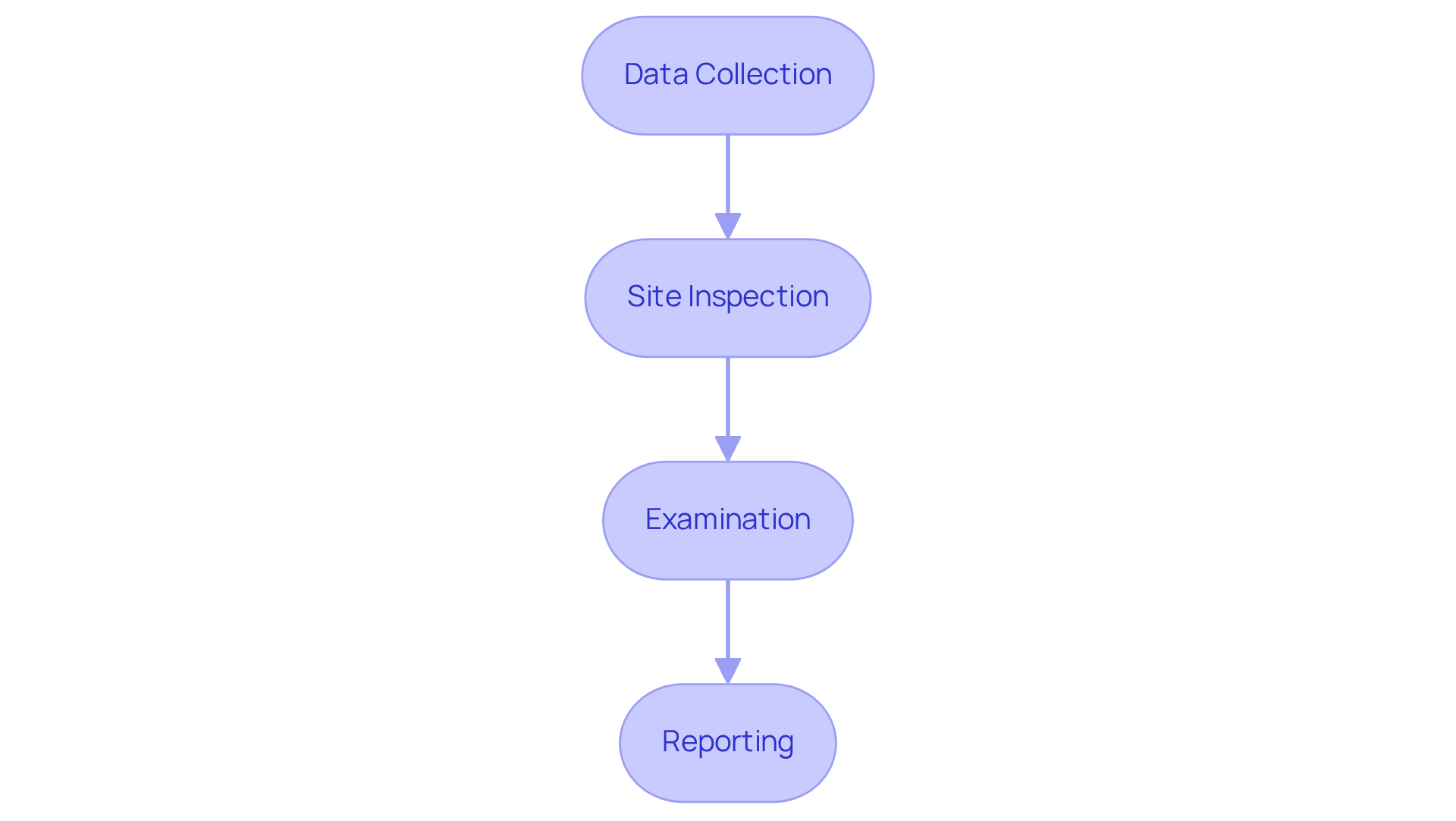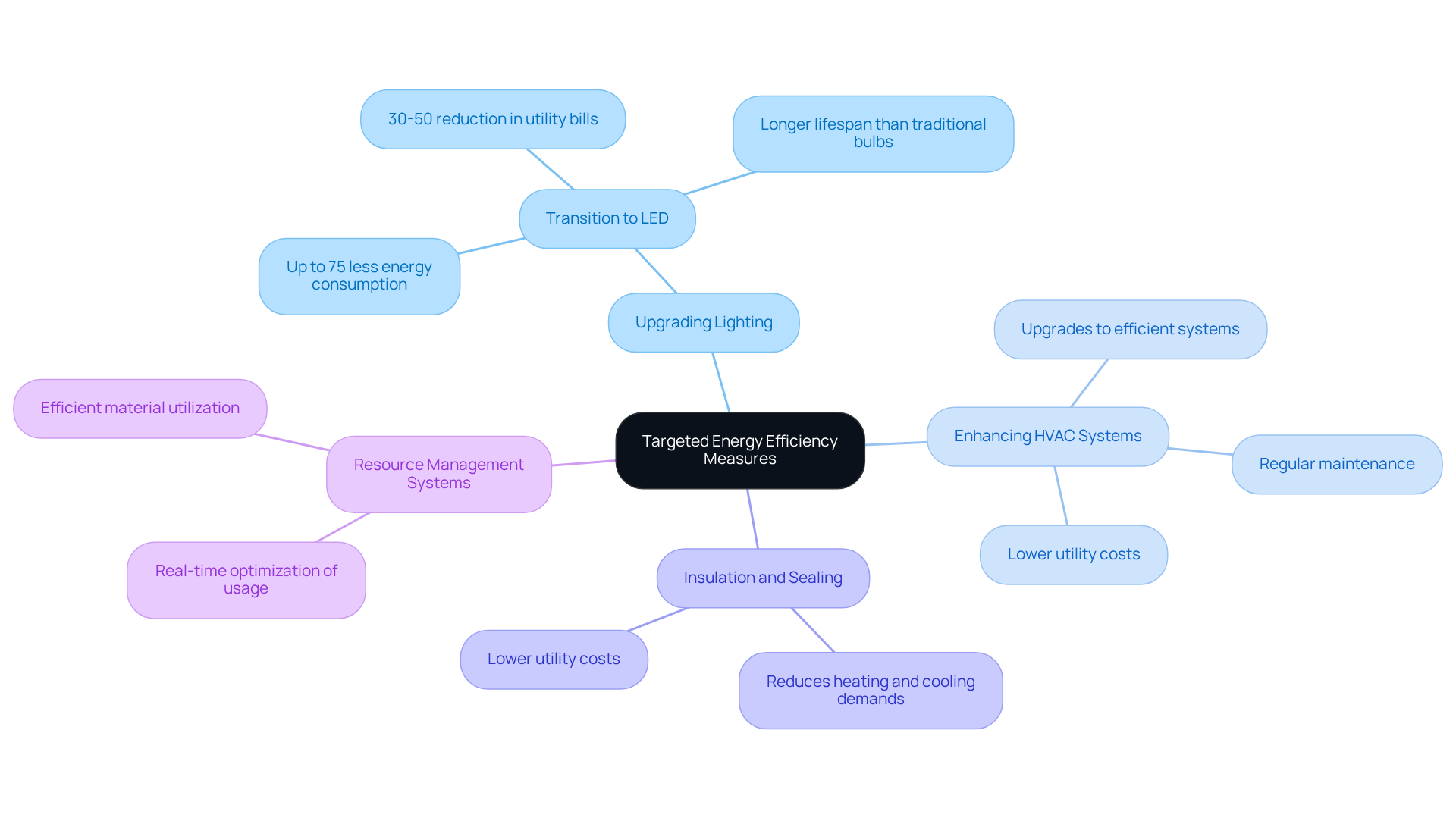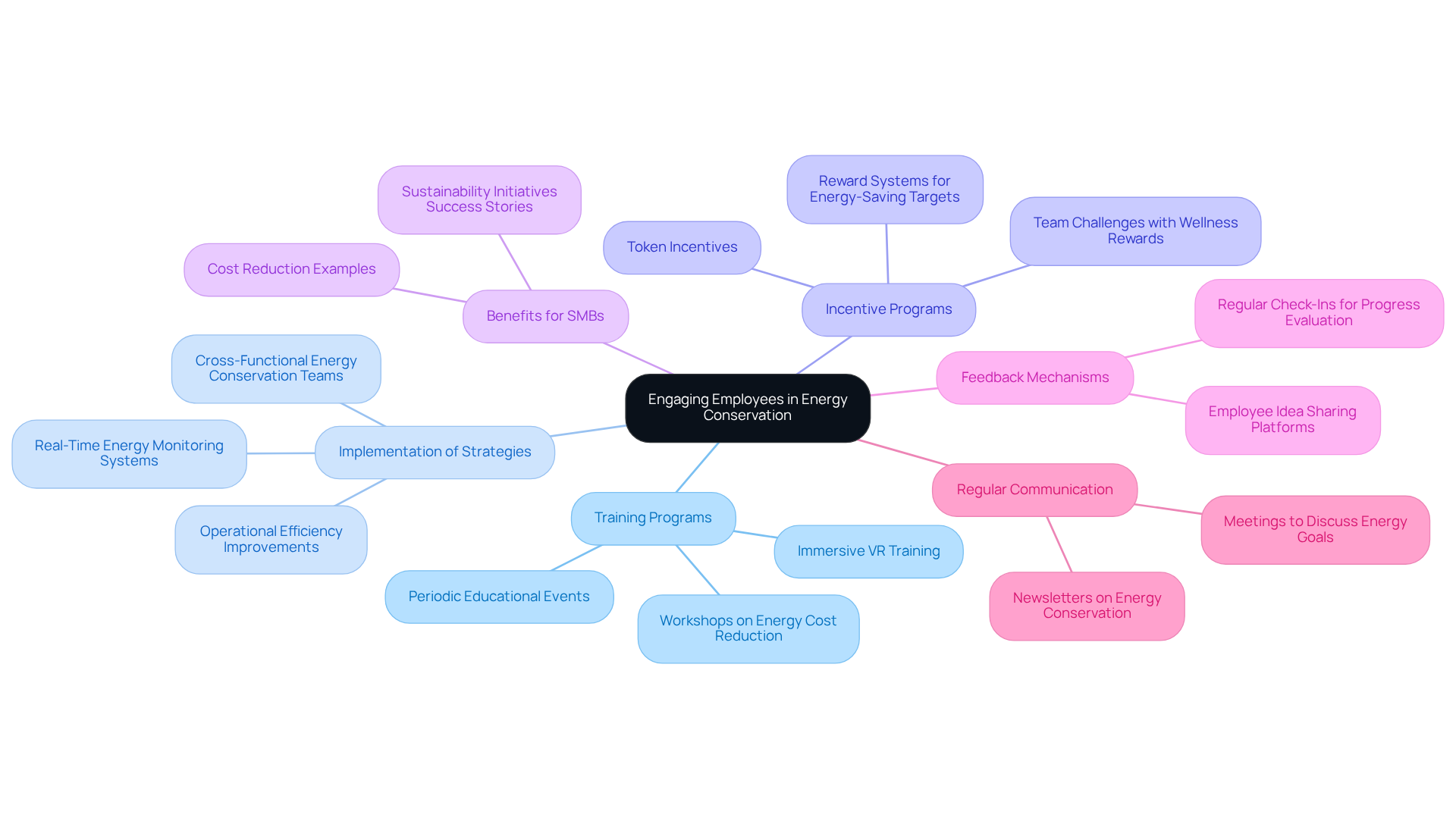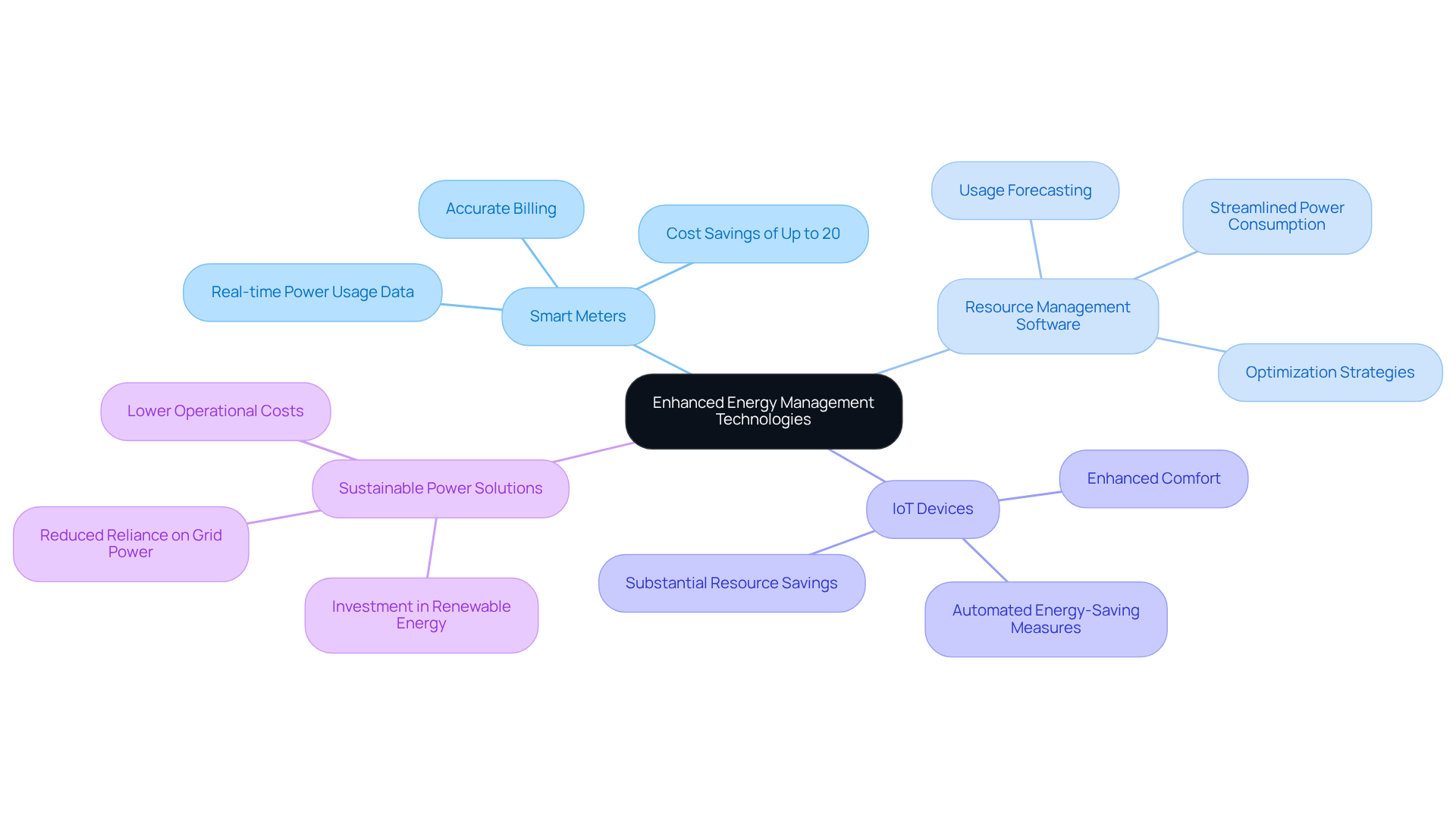Overview
This article presents four essential energy cost reduction strategies tailored for small and medium-sized businesses (SMBs), strategies that can significantly bolster their financial performance.
- Conducting comprehensive energy audits is crucial; these audits provide a detailed understanding of energy consumption patterns.
- Implementing targeted energy efficiency measures can lead to substantial reductions in operational costs.
- Engaging employees in conservation efforts fosters a culture of sustainability within the organization.
- Utilizing advanced technology for enhanced energy management not only optimizes usage but also drives significant cost savings.
Collectively, these strategies pave the way for operational improvements and financial success.
Introduction
The escalating energy costs pose a significant challenge for small and medium-sized businesses (SMBs), often jeopardizing their financial stability and growth potential. By implementing strategic energy cost reduction measures, these businesses can alleviate their financial burdens while simultaneously enhancing their operational efficiency and sustainability. However, the journey toward substantial savings raises critical questions:
- What specific strategies can SMBs adopt to effectively lower energy expenses?
- How can they actively involve their workforce in these initiatives?
This article explores four actionable strategies that empower SMBs to navigate the complexities of energy management and unlock considerable cost savings.
Conduct Comprehensive Energy Audits
A thorough resource assessment is crucial for companies seeking to enhance their consumption and apply energy cost reduction strategies for smb to lower expenses. This process typically involves several key steps:
- Data Collection: Gather historical utility bills, operational data, and equipment specifications to establish a baseline for analysis.
- Site Inspection: Conduct a thorough walkthrough of the facility to identify usage patterns and pinpoint inefficiencies.
- Examination: Utilize the gathered data to evaluate power usage and emphasize areas suitable for enhancement.
- Reporting: Deliver a detailed report that outlines findings, actionable recommendations, and potential savings.
For instance, a small manufacturing company that conducted an efficiency audit discovered that outdated machinery was accountable for excessive power usage. By upgrading to energy-saving models, the firm achieved a remarkable 30% decrease in yearly expenses. Moreover, companies that swap conventional HVAC systems for efficient models can reduce utility costs by as much as 40%, highlighting the possibility for even larger savings.
Routine power assessments enable companies to proactively employ energy cost reduction strategies for smb and adjust to the changing power environment. By implementing energy cost reduction strategies for smb, businesses that conduct these evaluations can decrease their power expenses by 20-30%. Furthermore, companies can save an average of 6% on their yearly utility bills by comparing and changing providers when executed properly. This makes resource assessments a crucial approach for implementing energy cost reduction strategies for smb and achieving sustainable financial well-being. For example, a bakery reduced costs by $1,200 each year by monitoring power consumption during non-working periods, showcasing the efficiency of resource assessments in pinpointing cost-reduction opportunities.
As the UK nears its Net Zero by 2050 goal, the increasing focus on renewable power production further highlights the significance of assessments in sustainable practices.

Implement Targeted Energy Efficiency Measures
Following a resource audit, companies must prioritize the implementation of energy cost reduction strategies for smb to maximize their savings. Key strategies include:
- Upgrading Lighting: Transitioning to LED lighting can lead to power usage reductions of up to 75% compared to traditional incandescent bulbs. Retailers can expect utility bill reductions of 30-50% specifically from efficient lighting systems, significantly impacting overall operational expenses.
- Enhancing HVAC Systems: Regular maintenance and upgrades to efficient heating and cooling systems can further lower utility costs, enhancing comfort while minimizing waste.
- Insulation and Sealing: Improving insulation and effectively sealing gaps reduces heating and cooling demands, resulting in lower utility costs.
- Resource Management Systems: Implementing intelligent resource management systems allows for real-time optimization of usage, ensuring materials are utilized efficiently.
Consider a retail store that adopted energy cost reduction strategies for smb by upgrading its lighting and HVAC systems; it achieved a remarkable 25% reduction in energy costs within the first year, demonstrating the effectiveness of these targeted measures. As advancements in LED lighting continue, forecasts suggest it may reach 250 lumens per watt in the coming decade, making the potential for additional benefits and enhanced sustainability increasingly attainable. Furthermore, companies should explore available financial incentives for transitioning to energy-efficient lighting, which can further enhance cost reductions.

Engage Employees in Energy Conservation Efforts
To enhance savings on power, companies must actively engage their staff in energy cost reduction strategies for smb. Effective strategies include:
- Training programs should conduct workshops that educate employees on energy cost reduction strategies for smb, fostering a culture of awareness and responsibility. Effective training methods can greatly impact employee behavior and support energy cost reduction strategies for smb in industrial resource consumption.
- The implementation of energy cost reduction strategies for smb is crucial for improving operational efficiency.
- Incentive Programs: Implement reward systems for teams that meet or exceed energy-saving targets as part of energy cost reduction strategies for smb, motivating participation and commitment.
- Implementing energy cost reduction strategies for smb can significantly benefit small and medium-sized businesses.
- Establishing feedback mechanisms will allow employees to share innovative ideas on energy cost reduction strategies for smb, encouraging a collaborative approach and fostering a culture of shared responsibility.
- Regular communication through newsletters and meetings will help maintain resource conservation and implement energy cost reduction strategies for smb, ensuring ongoing engagement and awareness.
For example, a restaurant that involved its staff in conservation practices—such as turning off unused equipment and optimizing cooking times—achieved a remarkable 15% reduction in costs within just six months. This underscores the considerable influence of employee participation in promoting energy cost reduction strategies for smb. Moreover, organizations like Unilever have demonstrated that engaging employees in sustainability efforts can lead to zero waste across factories, showcasing the broader implications of employee involvement on sustainability initiatives.

Utilize Technology for Enhanced Energy Management
Companies can significantly enhance their resource management practices by leveraging advanced technologies. Key technologies include:
-
Smart Meters: These devices deliver real-time information on power usage, enabling companies to pinpoint peak consumption periods and make informed adjustments. Research indicates that companies utilizing smart meters have recorded savings of up to 11%, with many experiencing a 20% reduction in usage within a year of implementation.
-
Resource Management Software: This software analyzes resource data, forecasts usage, and recommends optimization strategies tailored to specific business needs. By employing such software, companies can streamline their power consumption and implement energy cost reduction strategies for smb to uncover cost-saving opportunities.
-
IoT Devices: Internet of Things (IoT) devices automate energy-saving measures, such as adjusting lighting and HVAC systems based on occupancy. This automation not only enhances comfort but also results in substantial resource savings.
-
Sustainable Power Solutions: Investing in renewable energy sources like solar panels or wind turbines can significantly reduce reliance on grid power, resulting in lower operational costs and a diminished carbon footprint.
For instance, a compact office that implemented smart meters and resource management software achieved an impressive 20% decrease in consumption within just one year, underscoring the transformative potential of technology in resource management. Furthermore, the energy management system (EMS) market is projected to expand from USD 49.01 billion in 2025 to USD 84.34 billion by 2029, emphasizing the growing importance of adopting these technologies. However, small to medium businesses may encounter challenges such as high initial investment costs and limited capital accessibility, which can impede their ability to effectively implement energy cost reduction strategies for smb. As noted by Claire Maugham, Director of Policy and Communications at Smart Energy GB, "This research shows that smart meters are bringing real changes to people’s bills for the millions of homes who’ve already had theirs installed.

Conclusion
Implementing effective energy cost reduction strategies is vital for small and medium-sized businesses (SMBs) striving for financial sustainability and operational efficiency. By embracing comprehensive energy audits, companies can identify inefficiencies and uncover significant savings opportunities. This foundational step not only sets the stage for enhanced energy management but also equips businesses with the insights necessary to make informed decisions on energy-efficient upgrades.
The article explored several key strategies that SMBs can adopt to reduce energy costs:
- Upgrading lighting and HVAC systems
- Engaging employees in conservation efforts
- Leveraging advanced technology
Each approach offers unique benefits. For instance, transitioning to LED lighting can drastically cut power usage, while smart meters provide real-time insights that help manage consumption effectively. Moreover, fostering a culture of energy awareness among employees can lead to substantial savings, as demonstrated by various case studies.
Ultimately, the significance of implementing energy cost reduction strategies extends beyond mere savings; it contributes to a broader commitment to sustainability and responsible resource management. As businesses navigate the ever-evolving energy landscape, taking proactive steps towards energy efficiency not only enhances their bottom line but also aligns with global sustainability goals. Companies are encouraged to assess their current practices, engage their teams, and invest in technology that promotes efficient energy use, ensuring they remain competitive and responsible in an increasingly eco-conscious market.
Frequently Asked Questions
What is the purpose of conducting comprehensive energy audits?
The purpose of conducting comprehensive energy audits is to enhance energy consumption and apply cost reduction strategies, helping companies lower their expenses.
What are the key steps involved in a comprehensive energy audit?
The key steps involved in a comprehensive energy audit include data collection, site inspection, examination of power usage, and reporting findings with actionable recommendations.
What types of data are collected during the energy audit process?
Data collected during the energy audit process includes historical utility bills, operational data, and equipment specifications to establish a baseline for analysis.
How can energy audits lead to cost savings for businesses?
Energy audits can lead to cost savings by identifying inefficiencies and recommending upgrades, such as replacing outdated machinery or HVAC systems, which can significantly reduce utility costs.
Can you provide an example of a company that benefited from an energy audit?
Yes, a small manufacturing company that conducted an efficiency audit found that outdated machinery was causing excessive power usage. By upgrading to energy-saving models, the company achieved a 30% decrease in yearly expenses.
What potential savings can companies achieve by implementing energy cost reduction strategies?
Companies can decrease their power expenses by 20-30% and save an average of 6% on their yearly utility bills by comparing and changing providers when implemented correctly.
How does monitoring power consumption during non-working periods help businesses?
Monitoring power consumption during non-working periods helps businesses identify cost-reduction opportunities, as demonstrated by a bakery that reduced costs by $1,200 each year through such monitoring.
Why are energy assessments increasingly important as the UK approaches its Net Zero by 2050 goal?
Energy assessments are increasingly important as they highlight the significance of sustainable practices and the transition to renewable power production in achieving the Net Zero by 2050 goal.




